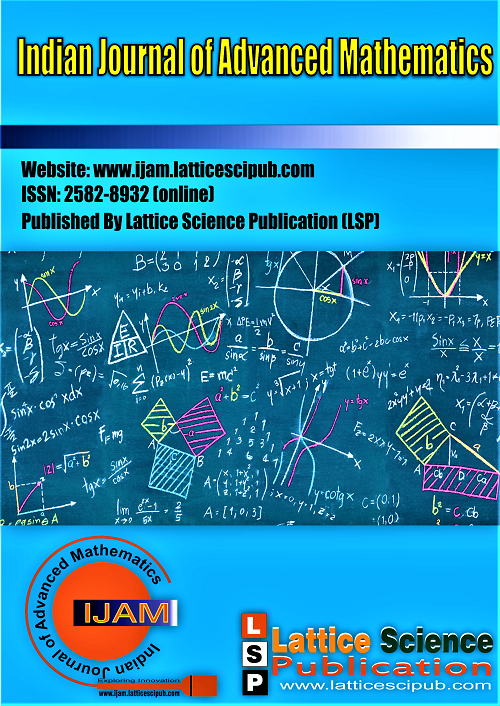Numerical and Analytical Method based Mathematical Approach to Estimate Water Pollution over 3-D Region
Main Article Content
Abstract
One of the major environmental issues is water pollution, which harms aquatic ecosystems, human health, and the sustainability of natural resources. To solve this problem, reliable mathematical models are required that can predict the behaviour of pollutants in three-dimensional (3-D) water systems. In this study, the temporal and spatial fluctuations of pollutant concentration in water are estimated using a 3-D diffusion model. The work's goals are to investigate the gradual rise in pollution levels in a 3-D region and assess the accuracy of analytical and numerical methods for addressing diffusion-based pollution issues. Two distinct mathematical techniques are employed to determine the level of pollution in water at a 3-D location: the Crank-Nicolson (C-N) method, a numerical method, and the Adomian Decomposition Method (ADM), an analytical method. The data collected from an experiment conducted in a 3-D cuboid tank, where water serves as the medium and iodised saltwater solution as the pollutant, are used to derive the initial and boundary conditions for the presented mathematical approaches. The dispersion of pollutants over time and space can be directly observed in this experiment, yielding crucial data for validating the mathematical model. The results of the experiments show that during all the time intervals, there is a rise in water pollution at all 3-D locations. Furthermore, the insignificant error in the form of parts per million (PPM) difference obtained when comparing the outcomes of the C-N with Experimental data (Exp. data) and ADM methodologies demonstrates the effectiveness of the proposed mathematical model. The benefit of this research lies in the use of mathematical approaches and experimental data to investigate water pollution in a 3-D region. The study demonstrates the validity of the proposed model and its ability to forecast the spread of pollution in water accurately. This method is also applicable to larger water systems than the experimental tank. The research enhances mathematical solutions to diffusion equations and provides valuable insights for developing pollution control measures, assessing water quality, and promoting sustainable water management.
Downloads
Article Details

This work is licensed under a Creative Commons Attribution-NonCommercial-NoDerivatives 4.0 International License.
How to Cite
References
Hanani Johari, Nursalasawati Rusli, and Zainab Yahya (2018). Finite Difference Formulation for Prediction of Water Pollution. Materials Science and Engineering. DOI: http://doi.org/10.1088/1757-899X/318/1/012005
Ahmed Saleh, Mourad F. Dimian and Fayez N. Ibrahim (2023). A Simplified 3D Model for Remediation of Pollution in a River by Releasing Clean Water Using the Advection-Dispersion Equation. Egyptian Journal of Aquatic Biology & Fisheries 27(5):411–427.
DOI: https://doi.org/10.21608/ejabf.2023.319123
Richard Fuller, BEng, Prof Philip J Landrigan, MD, et al. (2022) Pollution and health: a progress update. Lancet Planet Health 6(6): e535-e547. https://www.thelancet.com/journals/lanplh/article/PIIS2542-5196(22)00090-0/fulltext
Abdul Quddoos, Khalid Muhmood, Iram Naz, Rana Waqar Aslam, Syed Yasir Usman (2024). Geospatial insights into groundwater contamination from urban and industrial effluents in Faisalabad. Discover water 4, 50. DOI: https://doi.org/10.1007/s43832-024-00110-z
Jeffry Kusuma, Agustinus Ribal, Andi Galsan Mahie and Naimah Aris (2017) On pollution distribution on unhas lake using two-dimension advection-diffusion equation. Far East Journal of Mathematical Sciences (FJMS) 101(8):1721-1729. DOI: https://doi.org/10.17654/MS101081721
Rui Chen, Zhongwen Xu (2021) Modelling and Simulation of Water Pollution Diffusion with Seasonal Unsteady Input Flows: A Case Study from China. IOP Conference Series: Earth and Environmental Science 687. DOI: http://doi.org/10.1088/1755-1315/687/1/012003
Nigar Sultana and Laek Sazzad Andallah (2022). Investigation of Water Pollution in the River with Second-Order Explicit Finite Difference Scheme of Advection-Diffusion Equation and First-Order Explicit Finite Difference Scheme of Advection-Diffusion Equation. Mathematical Statistician and Engineering Applications 71(2):12-27. DOI: http://doi.org/10.17762/msea.v71i2.62
Delong Wan, Huiping Zeng (2018). Water environment mathematical model, mathematical algorithm. 2nd International Symposium on Resource Exploration and Environmental Science 170. DOI: http://doi.org/10.1088/1755-1315/170/3/032133
Rayne of the Wine Country: Decoding your water test: Understanding water hardness and TDS levels. Rayne of the Wine Country Blog (2025). https://rayneofthewinecountry.com/blog/decoding-your-water-test-understanding-water-hardness-and-tds-levels/
Tsegaye Simon, Purnachandra Rao Koya (2015) Modelling and Numerical Simulation of River Pollution using Diffusion-Reaction Equation. American Journal of Applied Mathematics 3(6):335-340. DOI: http://doi.org/10.11648/j.ajam.20150306.24
R. V. Waghmare and S. B. Kiwne (2017). Mathematical Modelling of Disposal of Pollutants in Rivers. International Journal of Computational and Applied Mathematics 12(3):835-842. https://www.ripublication.com/ijcam17/ijcamv12n3_20.pdf
Abbas Parsaie, Amir Hamzeh Haghiabi (2017). Computational Modelling of Pollution Transmission in Rivers. Applied Water Science 7:1213–1222. DOI: http://doi.org/10.1007/s13201-015-0319-6
Safia Meddah, Abdelkader Saidane, Mohamed Hadjel, Omar Hireche (2015) Pollutant Dispersion Modelling in Natural Streams Using the Transmission Line Matrix Method. water 7(9):4932-4950 DOI: http://doi.org/10.3390/w7094932
Almando Morain, Nivedita Ilangovan, Christopher Delhom, Aavudai Anandhi (2024). Artificial Intelligence for Water Consumption Assessment: State of the Art Review. Water Resources Management 38:3113–3134. DOI: https://doi.org/10.1007/s11269-024-03823-x
Snehashish Chakraverty, Nisha Mahato, Perumandla Karunakar, Tharasi Dilleswar Rao (2019). Advanced numerical and semi-analytical methods for differential equations. Wiley Telecom. 119-130. DOI: http://doi.org/10.1002/9781119423461.ch11
Suaad Hadi Hassan Al-Taai (2021). Water Pollution: Its Causes and Effects. IOP conference series Earth and Environment Science 790(1). DOI: http://doi.org/10.1088/1755-1315/790/1/012026
Raju, Mst. S. Banu, S. Mim, S. Hossain and H. K. Saha (2022). A case study on the simulation of the heat equation by the Crank-Nicolson Method in accordance with digital image processing. International Journal of Scientific and Engineering Research 13(1):461-465. https://www.ijser.org/researchpaper/A-Case-study-on-simulation-of-heat-equation-by-Crank-Nicolson-Method-in-Accordance-with-digital-image-processing.pdf
Zafenate Infinity (2022) Determining the Diffusivity Coefficients for the Different NaCl Concentrations Laboratory Assignment. Report on the Liquid Diffusion Coefficient of NaCl by BSC Gumede @ UJ Department of Chemical Engineering. https://www.researchgate.net/publication/360159270





